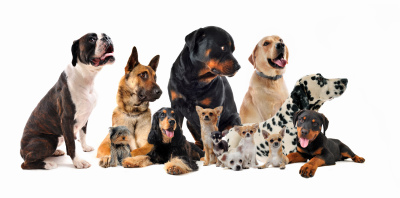- Home
- About Us
- Contact Us
- Privacy Policy
- What's New!
Dog Breed Selector`
You probably wouldn’t need our Dog Breed Selector if you already knew the breed of dog you want to get. Many of us fall in love with a particular breed for no apparent reason...
...there’s just something about them that “clicks” with us.
Even so, you should still do a bit of research on the breed before you commit...just to make sure it’s going to be a good fit for you and your family.
And, if you’re not familiar with a lot of breeds, you probably could use some help finding just the right one.
So I’ve compiled a chart (the Dog Breed Selector) of over 150 dog breeds listing the most important characteristics for you to consider.
From this chart you can easily narrow your selection down to a few breeds that you should check out in more depth (you’ll find links for more information included in the chart as new pages are added to the site).

Click here to open the Dog Breed Selector in another window.
How to use the Dog Breed Selector
The selector is very simple to use. Here are a few suggestions for getting the most out of it:
The chart is divided up into 4 sections based on the general size of the breed:
- Large - Dogs over 80 pounds.
- Medium - Dogs between 30 and 80 pounds.
- Small - Dogs between 15 and 30 pounds.
- Toy - Dogs under 15 pounds.
If you like larger breed dogs, you might want to consider both the Large and Medium categories. And if smaller dogs appeal to you, consider checking out both the Toy and Small categories.
- Consider each of the characteristics listed in the chart and compare them with your personal preferences, needs, and desires. You’ll find an explanation for each of the characteristics below.
- Narrow your list down to the top 3 or 4 breeds that you appear to meet your needs and desires. But, realize that there may not be a perfect match (you may not see everything you want in a particular breed), but you should at least be able to “live with” the characteristics you see.
- Further research each of the breeds on your short-list to find the breed that’s right for you and your family.
About the Dog Breed Selector
Each breed has been assigned a rating for each of 13 important characteristics. These are only to give you an idea of how a dog within this breed is likely to behave. Individual dogs may behave very differently from these average ratings. The ratings range from 1 to 5 where:
- indicates that the characteristic is not very noticeable.
- indicates that the characteristic is somewhat more noticeable than the average dog.
- indicates that the characteristic is about as noticeable as in the average dog.
- indicates that the characteristic is quite noticeable compared to the average dog.
- indicates that the characteristic is very noticeable.
The Chart is also color coded to show ratings that most people would consider the most desirable for a particular characteristic. Note: Your tastes or needs may be different.
Green = Most desirable rating
Yellow = Neither desirable nor undesirable
Red = Most undesirable rating.
For instance, most people would like a breed that’s easy to train. Therefore, any breed that scores a 4 or 5 in that category is color coded in Green. While any breed that scores a 1 or 2, is color coded with Red.
Understanding the Dog Breed Selector Categories
Each breed listed in the Dog Breed Selector is rated in 13 important categories. Read the description of each category below and decide how important that characteristic is to your breed selection. You may choose to completely ignore some categories that don’t seem to apply to your situation.
For instance, if you currently have no pets and don’t plan on getting any other pets, you may not care if the breed generally gets along with other pets.
Energy Level - All puppies have a ton of energy. These numbers, therefore, refer to what you can expect from an adult dog. Does a dog with lots of energy sound like fun or a nightmare to you?
- Will a high energy dog get on your nerves?
- Will a dog with low energy satisfy your desire for jogging partner?
Exercise Needs - All dogs need some exercise each day...you’ll notice that there are no zeros in the chart. If you choose a breed that requires a lot of exercise, will you have the time and energy to provide it? If not, choose a breed that doesn’t need much exercise.
Playfulness - Some breeds require more interaction with people than others. They may be constantly dropping a ball at your feet, begging you to play with them. You might ask yourself:
- Will I get annoyed with a dog that always wants to play?
- How much am I interested in playing with a dog?
Affection Level - Some dogs will jump all over you and lick your face every chance they get. How do you like a wet face with dog slobber all over it? Other dogs will show their devotion to you with less outward affection. Which would you prefer?
Good with other Dogs - Almost any dog may fight with a strange dog or even a familiar dog at times. This category indicates how likely a dog is to get along with other dogs. This is an important consideration if you have other dogs in the house or have contact with other dogs frequently.
Good with other Pets - Some breeds have been bred to chase and kill smaller animals. These breeds are much more likely to chase the family cat or other small animals. Carefully consider this category if you have other pets in the house. Most dogs can learn, however, to live peacefully with cats if raised with them.
Good with Strangers - Depending on your situation, you may not want a dog that’s overly friendly with strangers. But then again, you might. If you frequently have visitors and don’t want to keep your dog locked away, choose a breed that’s rated high for this characteristic.
Easy to Train - All dogs can be trained. But, some dogs require more repetition and patience than others. If you love spending time with your dog, this won’t be a problem. If you’re looking to get a “good dog” with the least amount of effort on your part, choose a breed that rates high in this category.
Good Watchdog - This category rates whether a breed is alert and barks when something is wrong. You may find that some dogs that rate highly in this category bark a lot. If barking annoys you, choose a breed that rate lower for this characteristic.
Good for Protection - Does this breed have the desire to protect as well as the physical ability to protect you and your family? Consider carefully before selecting a breed rated high for this characteristic. The idea of having a dog that will protect you and your family sounds great on the surface, but these dogs can be dangerous if not properly trained.
- You should also be aware that owning such dogs can disqualify you with some insurance companies for a homeowners policy. They consider the risk to high that the dog could harm someone.
Grooming Needs - A dog breed can have one of several different coat types. Some coats require more grooming than others. If grooming a dog is not your idea of fun, look for a breed with a low ranking for this characteristic.
Can take the Cold - Do you intend to keep your dog outside a lot and do you live in colder climate? Larger dogs with thicker coats tend to tolerate the cold better than smaller dog or dogs with shorter hair.
Can take the Heat - Generally speaking, dogs don’t tolerate heat well. That’s why you should never leave them unattended in a hot car. If you live in a hot climate, consider choosing a dog breed that ranks high for this characteristic.
A word of caution...
The ratings in this Dog Breed Selector are based on the standard characteristics of most dog of that breed.
There are, however, no guarantees that the particular dog you choose will have the typical characteristics for that breed. But, the chances are good that he will.
Don’t dismiss a breed just because it has a characteristic that you don’t like. Consider whether there are ways that you could deal with that characteristic so that it wouldn’t be a problem.
For instance, if you live in a cold climate and the breed doesn’t tolerate cold well, you could buy him a coat to wear outside in the winter.
Use the Dog Breed Selector as a guide to picking the right breed for you and your family, but use your heart as well. If you just love a particular breed...go for it (but with your eyes wide open)!






